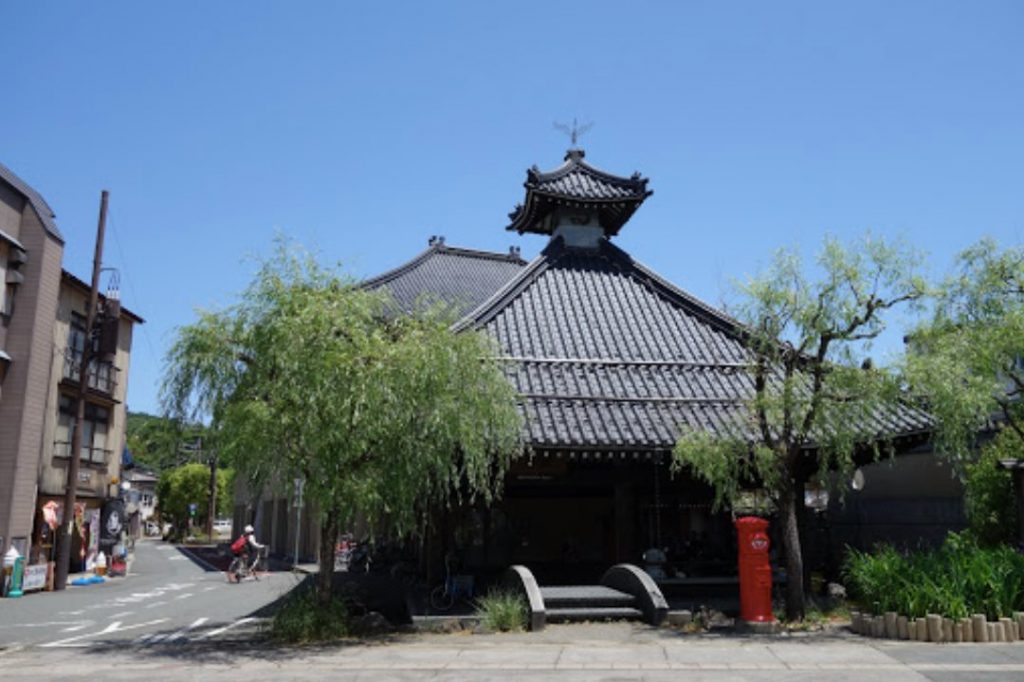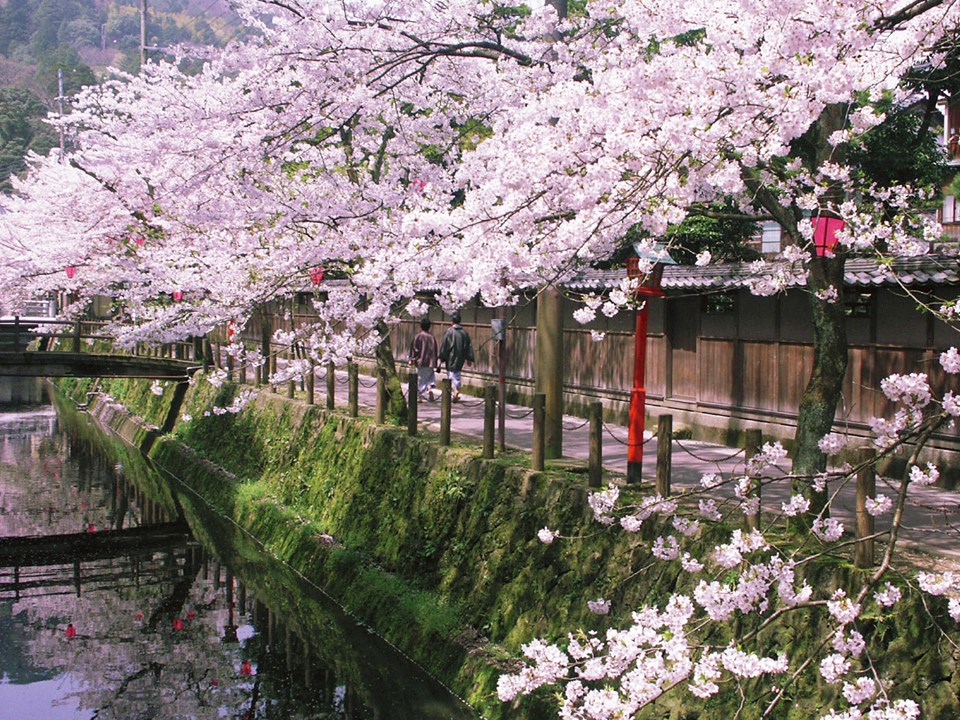Kyoto is on the tip of almost every first-timer’s (to Japan) tongue when asked about which destination was the most culturally rewarding to experience. Compared to other heavyweights such as Osaka and Tokyo, Kyoto offers an exceptional city stay for comfort, whilst being closely surrounded by wonderfully preserved natural and historical monuments and attractions that make it to easy to skip the hustle and bustle of crowds and traffic lights.

However, if you’re after an experience that’s truly Japanese, we recommend visiting a traditional onsen town, and Kinosaki Onsen town (2,5h away from Kyoto) is one of the most authentic experiences you can come across.
The town itself has been developing over 1300 years, and whilst it has only continued to blossom along the way, many of its old charm, its stunning traditional structures, and its warm, Zen ambience has been unwaveringly retained.
This is a unique aspect, and an important reason why many Japanese people choose Kinosaki Onsen over closer alternatives such as Arima Onsen. Whilst the latter is still a very popular choice, and cuts the travel time in half, Kinosaki Onsen is as genuine as it gets when it comes to a truly natural onsen experience.

Kinosaki Onsen is stunning throughout all seasons of the year, but we recommend going during winter in Japan, because that’s when the local specialty, snow crab, is at its peak, and who doesn’t love a searing hot onsen in 0-degree weather? Otherwise, the area is also gorgeous during the cherry blossom season, when you can walk around town in your stunning yukatas, and also in autumn in Japan, when you have burnt leaves cascading all around you.
How To Get To Kinosaki Onsen

The easiest way to get to Kinosaki Onsen is to take a direct “Kinosaki” Limited Express from Kyoto straight to Kinosaki Onsen Station. A one-way fair will cost you 4,320 yen, and take just under 2.5 hours to get to. There are approximately three trains that leave for Kinosaki Onsen Station daily.
Where To Stay In Kinosaki Onsen
Kinosaki Onsen Hanakouji Saigetsu
All Kinosaki Onsen accommodations are authentic in every way, but the Kinosaki Onsen Hanakouji Saigetsu brings it up a notch. This ryokan is offers the premium Japanese experience, with tatami mat wooden flooring, stunning décor and detailed shoji screens, and traditional onsen baths for those who are keen for hours of relaxation.
Its best feature? Its location. It’s set right next to station, and amongst a plethora of restaurants that you’ll feel spoilt. It’s also close to a number of other attractions that will keep you on your toes. Breakfast is available for all guests in the morning.
Book It Now: Kinosaki Onsen Hanakouji Saigetsu
Kinosaki Yamamotoya
This ryokan has a reputation of consistently being sold out, so if you’re after a premium Japanese ryokan experience, make sure to book Kinosaki Yamamotoya in advance. Like other traditional Japanese inns, this ryokan offers superb Japanese-style rooms, however, unlike other traditional Japanese inns, it also has an on-site brewery you can check out! You can also pay a bit extra to experience a traditional Japanese tea ceremony.
The futon bedding has been praised highly by past guests as being super fluffy and comfortable, and each room is larger than the average, offering flat-screen TV entertainment and an iPod dock. Make sure you book breakfast as well, as it will be brought straight to your room in the morning for a completely Zen dining experience.
Book It Now: Kinosaki Yamamotoya
The Seven Onsens Of Kinosaki

The philosophy of Kinosaki Onsen is that the entire town is to be treated like one large ryokan, and this philosophy is built upon the original Seven Onsens that are all located within walking distance to each other.
Of course, there are multiple ryokans to book that provide their own private and open-air onsens in Kinosaki. However, the real attraction to this hot spring town are these original seven public bath houses (called ‘soto-yu’) that allow anyone to enter to use for a small fee.
Here is a brief presentation of these seven gorgeous hot springs.
1. Mandara-Yu

Known as Kinosaki’s very first onsen and what is believed to have started the long history of hot spring bathing in Kinosaki, this onsen was documented as being discovered by a priest who was traveling the country helping those who were were suffering, and found the waters here to be able to heal all ailments and illnesses.
Today, it stands as one of the more popular bath houses to visit, and it may be due to the idea that it’s also one of the most physically attractive of the onsens. It’s located just off the main road, but still within walking distance to all other onsens.
- Address: 565 湯島 城崎町 Toyooka, Hyogo 669-6101, Japan
- Hours: 3:00pm – 11:00pm (Closed Wednesdays)
- Price: Adult: 600yen, Child: 300yen
- Access: 15-minute walk from station
2. Sato-no-Yu

This onsen might actually be one of the most popular onsens due to its location alone – it’s directly next to the station. It’s a large onsen that can accommodate quite a few visitors at once, and includes a salt sauna, Arab sauna, and ice-cold sauna.
There are different styles of baths on each level, but they alternative between males and females every day, so to get the full experience of all their baths, you will need to visit two days in a row.
- Address: 290-36 Kinosakicho Imazu, Toyooka, Hyogo 669-6103, Japan
- Hours: 1:00pm – 9:00pm (Closed Mondays)
- Price: Adult: 800yen, Child: 400yen
- Access: 1-minute walk from station
3. Gosho-no-Yu

Translating to “imperial palace bath” due to its re-model on 2005 to look like the Kyoto Imperial Palace, this place is also one of the larger bath houses. One of its more popular features includes a multi-story outdoor bath which faces a waterfall, as well as a steam sauna that you can sit in whilst onsen water is sprayed in the air to create a fine mist. It’s closed on the 1st and 3rd Thursday of every month.

- Address: 448 湯島 城崎町 Toyooka, Hyogo 669-6101, Japan
- Hours: 7:00am – 11:00pm (Closed 1st and 3rd Thursdays)
- Price: Adult: 800yen, Child: 400yen
- Access: 12-minute walk from station
4. Kou-no-Yu

Kou-no-Yu has been rebuilt many times to become what it is today. It is a simple onsen, located closest to the ropeway entrance, that features a gorgeous outdoor rotenburo that offers stunning views of the surrounding forests – the ultimate Zen experience.
- Address: 610 Kinosakichō Yushima, Toyooka, Hyogo 669-6101, Japan
- Hours: 7:00am – 11:00pm (Closed Tuesdays)
- Price: Adult: 600yen, Child: 300yen
- Access: 20-minute walk from the station
5. Ichi-no-Yu

This one is one of the most convenient onsens to visit, being located right in the centre of the town. It’s famous for its outdoor “cave” bath”, whilst indoors it offers modern granite for customers to enjoy. You can also book private family baths for 3,000yen for 40-minutes here if you wish.
- Address: 415-1 Kinosakichō Yushima, Toyooka, Hyogo 669-6101, Japan
- Hours: 7:00am – 11:00pm (Closed Wednesdays)
- Price: Adult: 600yen, Child: 300yen
- Access: 10-minute walk from station
6. Jizo-Yu

One of the distinct features of this onsen is its high indoor ceilings, which is rare for onsens to have. However, don’t go here expecting to take in beautiful views whilst in an outdoor onsen, because it does not offer one – only indoor. There are also private family baths here for rent at 3,000yen for 40 minutes.
- Address: 796 Kinosakichō Yushima, Toyooka, Hyogo 669-6101, Japan
- Hours: 7:00am – 11:00pm (Closed Fridays)
- Price: Adult: 600yen, Child: 300yen
- Access: 5-minute walk from the station
7. Yanagi-Yu

This onsen is one that most closely resembles that of a traditional onsen, with its hand-cut wooden features. It’s one of the smaller onsens, and it’s got a relaxing vibe that whispers ‘solace’ from the moment you enter, which many people find appealing. It also offers a small ‘ashiyu’ (foot bath) next to the entrance which people can use for free.
- Address: 647 Kinosakichō Yushima, Toyooka, Hyogo 669-6101, Japan
- Hours: 3:00pm – 11:00pm (Closed Thursdays)
- Price: Adult: 600yen, Child: 300yen
- Access: 8-minute walk from the station
Kinosaki Onsen Ropeway

Japan is all about the views from up top, and Kinosaki Onsen does not disappoint. If you’re one to seek sweeping views of wherever you’re visiting, then remember to schedule in some time to take the Kinosaki Onsen Ropeway up to Mount Dashi’s summit.
If you’re quite fit, you can actually hike from the foot of the mountain near Onsenji Temple’s gate to the main temple, which is mid-way up the ropeway. This hike takes about 20-minutes. You can then take the ropeway the rest of the way up to the summit, or hike the rest of the way up, which will take you an additional 30-40minutes.

From up here, you’ll be able to see how uniquely structured the city is – a cluster of buildings lined along the riverbed, surrounded by Maruyama River, the Sea of Japan, and green mountains as far as the eyes can see. There’s a small café at the top for you to relax and grab a drink at, and you can also continue hiking towards Mount Kuruhi (1.5 hours) if you’d like.
- Address: 806-1 Kinosakichō Yushima, Toyooka, Hyogo 669-6101, Japan
- Hours: 9:10am – 5:10pm (every 20 minutes) (Closed every 2nd and 4th Thursday of each month)
- Price: Round-trip: 900yen, One-way: 460yen
- Access: 15-20minutes from the station.
Visit Onsenji Temple

This temple is dedicated to a Buddhist saint who, according to history, prayed for 1000 days for spring water to rush through Kinosaki. It’s a humble structure that is a nice place to visit whilst visiting Mount Dashi.
Onsenji Temple has a special ritual where its main attraction, a two-meter tall, multi-headed Buddha statue is brought out to be displayed to the public on a 33-year cycle, for only 3 years. It’s current being displayed until April 24, 2021.
Most of the temple’s main buildings are located halfway up the ropeway, however, there are some additional structures around the foot of the mountain to explore.
- Address: 985-2 Kinosakichō Yushima, Toyooka, Hyogo 669-6101, Japan
- Hours: 9:00am – 4:30pm (Museum opens until 4:00pm)
- Price: 400yen
- Access: 15 to 20-minute walk from the station.
As one of the lesser known onsen areas to visit, we highly recommend putting this one on your list if quiet and seclusion, a fully traditional bathhouse experience, mountainous views and crispy fresh air is what you’re after. A few days here and you’ll be recharged and ready to tackle the metropolis cities of Japan again!
Before to finish, I would like to invite you to join our community on Facebook so you can get and share travel tips about destinations in Asia.









